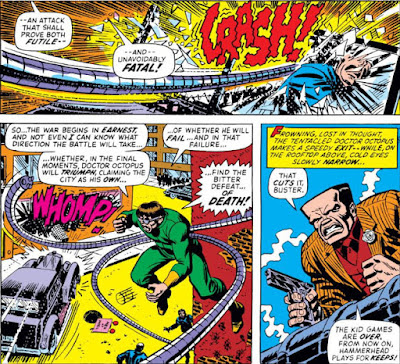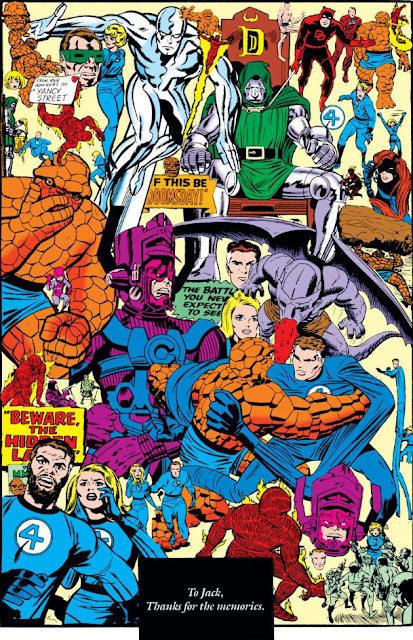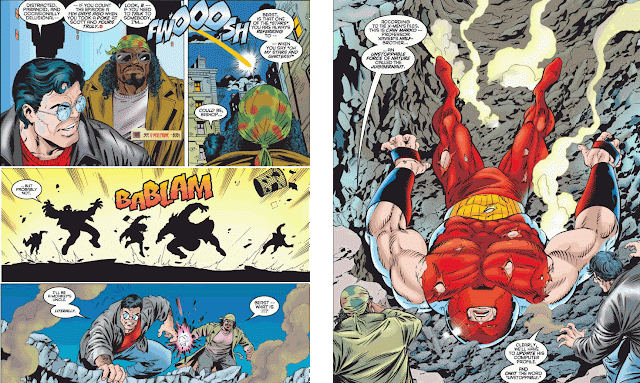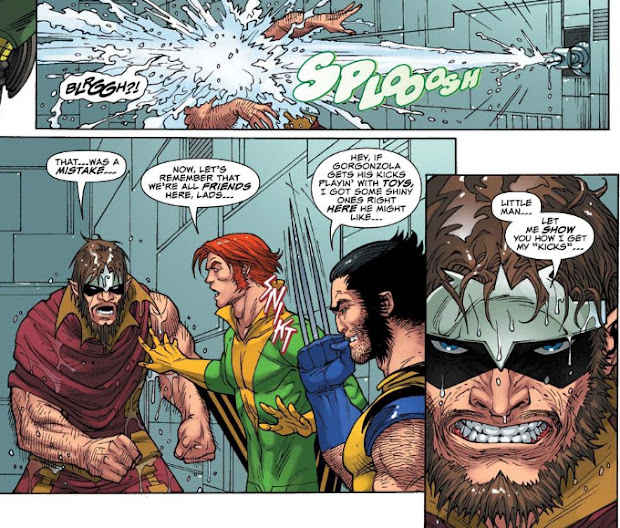Wednesday, September 30, 2015
Clash Of The Crime Lords!
It's always a lousy situation when two rival crime lords are interested in claiming the same turf--lousy for them, but top-notch entertainment for comics readers who are interesting in seeing which tough-talking villain has the smarts and the strength to prevail over the other. One such "gang war" that comes to mind is the late-1972 clash between Otto Octavius (a/k/a Dr. Octopus--"Doc Ock" to his friends and wise-cracking enemies) and Hammerhead, the new thug in town who's literally muscling in on New York City at the same time that Ock is staking his own claim on the territory.
When these two butt heads, they clearly have different ways of conducting their affairs in terms of tactics and weaponry. Ock, not surprisingly, makes use of sophisticated technology across the board, whether it's employed through surveillance, or communications, or weapons; while Hammerhead, a strict follower of the methods and style of late-1920s gangsters, relies on old-style weaponry and fear-inducing hits to build both his reputation and his power base. Initially, both men are focused on making strikes against each other in order to remove their threat as quickly as possible--and both have their share of setbacks as well as inroads.
The first round of their clash must go to Ock--who's walking into a canny trap laid by Hammerhead, but winds up turning the tables beautifully on his assassins.
(You have to admire a villain who has the boldness to confiscate the Kingpin's headquarters and equipment to further his own ends.)
Later, Ock must deal with the interfering Spider-Man, who's unfortunately caught in the middle of this war. Ock shrewdly ends up saving Spider-Man from being killed by Hammerhead, in order to gain an unwitting ally who might prove useful against his gangster-rival--and in the process, the war between Ock and Hammerhead explodes into the open and escalates.
Ock then retreats to another base of operations in Westchester where he employs May Parker as a housekeeper, further complicating Spider-Man's efforts to bring down both Ock and Hammerhead. Hammerhead, however, has put a "tail" on Ock and learns of his location, and immediately invades the property in force. Naturally, the taunts between both men fly as thickly through the air as the bullets laid down by Hammerhead's men.
Ock then retreats to a "safe room," while bringing his own armed men and technology into play to deal with Hammerhead's ill-prepared forces.
With Spider-Man on the premises, and the relentless Hammerhead still a threat, Ock decides to withdraw rather than trust in his men to turn the tide. Of course if Ock had joined the fray after deploying his men, who knows how this encounter might have turned out? Suffice to say that Ock inevitably finds that he has his hands--er, arms full with the attack of Hammerhead.
With Ock easily a match for Spider-Man, my money would be on Ock to come out on top in this fight. But it looks like Hammerhead is flanked by enough men (and with enough bullets) to send Ock into retreat.
Ironically, neither of these men comes out of this with their forces intact so as to declare victory over the other. Ock is in police custody (thanks to his run-in with a very angry Spider-Man), while Hammerhead is on the run and forced to lay low. Yet the two would clash again, with explosive results.
Tuesday, September 29, 2015
The Final Fate of Mr. Fantastic!
OR: "Strangers In The
 If you've ever wondered how far a man like Reed Richards could fall--well, just remember, there was once a time when we were all equally dismissive of such a question being applied to Tony Stark, and we learned a hard lesson on that one. Lately, we've seen how even a man like Reed can suffer only so much loss before he finally loses his perspective on right and wrong. First, there was his error in judgment which caused him to fail his teammates in the Fantastic Four as they faced the first coming of Galactus; then, upon his return to them, he found them dead amidst the ruins of his world, decimated by the drain of its life energy. Finally, as the Dark Raider, he began an insane mission to eradicate every Reed Richards from every alternate reality, in what seemed a mixture of grief, rage, and a search for redemption while "stopping" those alternate versions of himself before they too could doom their own worlds. When he arrived on "our" Earth to eliminate the Reed that we know, it was the Watcher who intervened and seemingly obliterated him before he could continue to cause further deaths.
If you've ever wondered how far a man like Reed Richards could fall--well, just remember, there was once a time when we were all equally dismissive of such a question being applied to Tony Stark, and we learned a hard lesson on that one. Lately, we've seen how even a man like Reed can suffer only so much loss before he finally loses his perspective on right and wrong. First, there was his error in judgment which caused him to fail his teammates in the Fantastic Four as they faced the first coming of Galactus; then, upon his return to them, he found them dead amidst the ruins of his world, decimated by the drain of its life energy. Finally, as the Dark Raider, he began an insane mission to eradicate every Reed Richards from every alternate reality, in what seemed a mixture of grief, rage, and a search for redemption while "stopping" those alternate versions of himself before they too could doom their own worlds. When he arrived on "our" Earth to eliminate the Reed that we know, it was the Watcher who intervened and seemingly obliterated him before he could continue to cause further deaths.Hold on a minute: "seemingly"?
Perhaps the thought to take away from that apparent killing stroke is that, for the Watcher, his biggest transgression in that moment was his decision to act, rather than continue to stand by and observe.
Speaking of the Watcher, who seemed to be the running theme in the issues leading up to Fantastic Four #400, the time comes when the FF finally confront Aron, the renegade Watcher, who had partnered to an extent with the Dark Raider in order to accomplish his ends. In the course of battling the FF, Aron strikes at Sue and effectively takes her out of the fight, banishing her to a chilling destination which, in the course of her career, she has become more than familiar with.
What happens next, however, takes her even more by surprise. Her husband, Reed, has been presumed dead following a battle with Dr. Doom, though she has never given up hope that he might somehow have survived that encounter. And now, after almost 20 issues have passed without a sign of him, Sue's patience and hope are finally rewarded, amidst an environment which would explain why there has been no sign of Reed for so long.
Yes, this is Reed Richards. But in the "too good to be true" department, Sue has instead encountered a deadly enemy--one whom she's met before, during a spree of murder that soon enough brought him to her own world.
As we can tell from Reed's rantings in this penultimate issue to FF #400, things with Aron and whatever upcoming crisis he's involved with are coming to a head. But even fighting for her life against the former "Dark Raider," Sue takes the opportunity to probe for more information on what Reed knows of the situation--including why the Watchers seem to be at the center of it.
Resourceful as Reed is, however, he can't anticipate everything--including the forces of this universe that render him virtually helpless as he beings to plummet toward the planet's exploding atmosphere.
Sue, of course, will at least try to save Reed, despite this man's state of mind and his attempts to subdue her. But aside from her weakened state which hampers her focus and concentration, and thus her power to project her force field, there's another reason why her rescue attempt is likely to fail--can you spot it? (And with those words, you've even been given a hint!)
Exactly. Given all the times that Sue has made a point to attach the word "invisible" to her exclamations when using her power (e.g., "my invisible force field will..."), the word is conspicuously absent in this one scene where its use would have virtually announced the reason why her attempt would fail. In other words: How is Reed supposed to reach out and grab a force-field lifeline that's invisible?
Regardless, Reed perhaps spoke more truly than he knew, when he said he was "doomed." Indeed he was, at the moment when he decided to abandon his dead world and embark on his murderous course of action, effectively putting himself on a collision course with his own end. Perhaps it's easy to condemn this Reed, when under other circumstances we could probably picture the Reed of our world finding a way to turn defeat into victory and reverse the events which led to his world's end; yet the Reed who became the Dark Raider was also battling something deep within himself that he wasn't willing to face up to, an aspect of himself that he nevertheless knew made him indirectly responsible for the death of his Earth. Carelessness is something our Reed often strives to avoid--and given what we've seen in these stories involving another Reed Richards who failed in that respect, perhaps we've seen an example of how his sense of responsibility can be carried to its extreme.
BONUS:
From earlier in the "Nobody Gets Out Alive!" arc,
a homage to the FF's most prolific artist/creator.
Monday, September 28, 2015
The Rebellion Strikes Back!
There's been no dearth of Star Wars-based comics since Marvel produced its six-issue adaptation of the 1977 film, going on to extend the comic to a series of 107 issues which folded its tent in July of 1986. From there, the business side of the equation gets interesting. Coincidentally, that same month, a new comic book company--Dark Horse Comics, which specializes in its treatment of comics based on films--opened up shop and published its first comic book, Dark Horse Presents #1; three years later, the company began to work to acquire the rights to publish comics based on the Star Wars story and characters. Finally, in December of 1991, the company released its first Star Wars title, Star Wars: Dark Empire #1--a launch which began a very successful association with Star Wars for Dark Horse, producing roughly over 100 series and one-shots in a run that lasted over two decades. Clearly they must have been doing something right.
Meanwhile, in late 2009, Disney acquired Marvel Entertainment for a cool $4 billion--and, not stopping there, went on to acquire Lucasfilm in 2012 for the same amount. Practically in the same breath, Disney announced a new Star Wars film trilogy would be produced, with its first "episode" scheduled for release in December of 2015. If you were employed at Dark Horse Comics, you didn't exactly need the clairvoyant properties of the Force to realize what announcement was likely to come when Disney next stepped up to the podium mic in January of 2014: the Star Wars comics license would return to Marvel as of 2015, with three new Star Wars books being launched in March of that year.
 While there's no doubt that Dark Horse would have published comparable Star Wars books of its own during 2015, Marvel has released some very nice product in its three series: Star Wars (its main title), Star Wars: Darth Vader, and Star Wars: Princess Leia, all set in the period of time directly following the destruction of the first Death Star, which of course was first attempted when new stories were published in 1978 following the adaptation of the '77 film. But unlike those earlier stories from Marvel, this "do-over" of sorts doesn't lose focus of its three main draws--or, rather, four, if you include Vader in the mix with Luke, Han, and Leia. There's a wealth of story material waiting to be mined following the Death Star's destruction, as the rebel alliance scrambles to capitalize on its momentum while the Empire increases its efforts to pursue and deal with them. The advantage could swing either way, at any time; but for now, the Empire's resources and power base give it the edge.
While there's no doubt that Dark Horse would have published comparable Star Wars books of its own during 2015, Marvel has released some very nice product in its three series: Star Wars (its main title), Star Wars: Darth Vader, and Star Wars: Princess Leia, all set in the period of time directly following the destruction of the first Death Star, which of course was first attempted when new stories were published in 1978 following the adaptation of the '77 film. But unlike those earlier stories from Marvel, this "do-over" of sorts doesn't lose focus of its three main draws--or, rather, four, if you include Vader in the mix with Luke, Han, and Leia. There's a wealth of story material waiting to be mined following the Death Star's destruction, as the rebel alliance scrambles to capitalize on its momentum while the Empire increases its efforts to pursue and deal with them. The advantage could swing either way, at any time; but for now, the Empire's resources and power base give it the edge.Since we've already looked at the first 1977 Star Wars adaptation in depth here at the PPC, I was very curious to see how Marvel would treat the product over 30 years later. As opposed to the first time around, with the '77 comics just riding the wave of the first film's popularity and success, obviously Marvel's 2015-2016 books will cash in on the anticipation (and hopefully good reception afterward) of the release of Star Wars: The Force Awakens in December; but unlike the Princess Leia book, the other two new offerings are reported to be continuing series, which will require quite a commitment on the part of their creative teams should they decide to remain with them. (For example, artist John Cassaday appears to have already left the main book after six issues.) That said, these early issues have proven to be very satisfying reads that address a number of points the late '70s series put on hold in favor of placing a greater emphasis on new characters and adventure. We immediately are reminded, for instance, that Luke--to quote Vader--is "not a Jedi yet"; that Leia, with the destruction of Alderaan and the ruling family, must assume a different role for herself as well as be mindful of how their loss affects those now under her command; that Vader, a thrall of the Empire, finds himself in the position of making up for the loss of the Empire's most powerful battle station and dealing with the repercussions; and that Han has pretty much burned his bridges as far as being an under-the-radar smuggler, having cast his lot with the rebellion.
All of these developments are logical follow-ups to the conclusion of the first film; and writers Jason Aaron, Kieron Gillen and Mark Waid sensibly pick things up just about where the film leaves off (in the Princess Leia book, virtually to the second). And in a nod to the opening moments of each Star Wars film, Marvel's practice of summarizing prior events of a story on the first page of each comic has been suitably adapted to a style that Star Wars fans will find familiar.
Friday, September 25, 2015
When Began Galactus!
Even though the planet-devouring Galactus first appeared as part of an unforgettable story in the pages of Fantastic Four, and would return to that book in another story two years later, it seems fitting that his origin should be revealed in a setting that spanned worlds and involved those on a power scale well beyond the scope of Earth and its inhabitants. After all, Galactus must be considered something of a scourge by most intelligent life throughout the galaxy, with the survivors of his attacks scattered and migrating through star system after star system. Hasn't it occurred to any space-faring race to do something about this deadly and persistent threat which is decimating life-sustaining worlds without mercy?
It's occurred to the Rigellians, who are well acquainted with another powerful figure of the stars whom they could approach about dealing with this world-devouring menace--and they know him well enough to realize that he will be incensed at the plight of innocents whose worlds have been ravaged by an uncaring aggressor.
(And the fact that their choice is a god doesn't hurt, either.)
At this point in time, Galactus is battling for supremacy against Ego, the Living Planet--and while the struggle has been fierce from both combatants, Galactus eventually weakens his foe to the point of standing poised to triumph. But while both Thor and the Rigellians have had their own difficulties with Ego when it was bent on conquest, Thor intervenes on Ego's behalf and engages Galactus in battle, which results in Galactus being driven off.
The encounter is enough to get Odin's attention, who recalls Thor--and, with the other Asgardians assembled, Odin uses his power to peel back time and view the beginnings of Galactus being loosed upon the universe.
Writer Stan Lee gives a slip of the pen here, causing Thor to misspeak and give the impression that Galactus has destroyed his own world--when in actuality, Galactus was still in his stage of incubation within his ship that had been in orbit above this planet, and first emerged as Galactus just as the planet came under siege by conquerors from another world. At that point, Galactus wastes no time in undertaking his new life's purpose--laying waste to the attacking space fleet, and then using his power to drain the world below of its life force.
Odin then concludes the audience, but Thor makes it obvious why Odin plans to pursue the matter further:
Time passes, and Odin seeks without success to gain more information on the origin of Galactus (specifically, the secret of his "incuba-sphere"), before finally settling on the direct approach and beginning construction of a special ship that will seek out Galactus himself for answers--a quest that may take ages. As for the ship's pilot, the perfect Asgardian practically drops into Odin's lap: Thor himself, who must do penance for falling prey to the forbidden "warrior madness" (i.e., battling his foe in unreasoning revenge while becoming merciless in the process and refusing to accept their surrender) and is chosen to serve that penance with this assignment. Naturally, we don't want to wait around for ages before Thor finds the one he seeks--so it's Thor who's found by Galactus almost immediately upon setting out on his mission, in back-to-back issues that will finally reveal the information on this being that has piqued the interest of Odin.
(Though in this case, Odin might have found himself elbowed aside by curious readers.)
Thursday, September 24, 2015
Wednesday, September 23, 2015
The Armor And The Ant-Man!
Iron Man has finally beaten the Hulk. But at what cost?
When Iron Man delivered his Sunday punch to knock out the Hulk, he went through practically every other day of the week in the process--because when the dust settled, not only was the Hulk out for the count, but Iron Man tipped over and hit the ground like a paperweight. That's not usually how the victor leaves the scene of a battle, is it?
And in the aftermath, things seem even worse to Tony Stark's close friend, James Rhodes. Iron Man remains nonresponsive, while the question of the Hulk's custody is being discussed by Bruce Banner's doctor, surgeon Erica Sondheim, and law enforcement authorities. What no one at the scene knows is that Stark is Iron Man--and so no one is available to settle either the matter regarding the Hulk's disposition or emergency procedures for Iron Man.
Fortunately, Rhodey thinks on his feet--and since Iron Man's armor has sealed itself completely, preventing any contact from without or within, he focuses on finding another method to probe for any signs of life.
Scott Lang, a specialist in electronics and one of Stark's most loyal employees, is also at the scene, and rushes to make preparations to lend his unique talents to the situation. Like Iron Man, Lang also has a secret identity, as a hero well-suited to getting inside a suit of armor that's virtually impregnable:
With Iron Man's mask slits sealed, Lang decides to gain entry to the armor by forcing the iris openings of the duct shields to its boot jets--and just as Lang's predecessor, Henry Pym, once journeyed inside the Vision as Ant-Man, Lang now finds himself making his way through a complicated and now dangerously unstable piece of man-sized machinery to search for a way to depolarize Iron Man's armor before the man inside suffocates.
Lang has two important things going for him--his electronics expertise that allows him both to communicate with Iron Man and to comprehend the information he receives on the armor's systems, and the full-sized strength of a normal man he retains as Ant-Man, which helps him escape from and deal with the malfunctions he encounters. Before you know it, he's reached the necessary wires to shut down the armor--and, with Iron Man's air supply having run out, just in time.
As for Bruce Banner, Dr. Sondheim has managed to shut down the chest implant that was elevating his heartbeat and keeping him in his Hulk state--but law enforcement officers are still waiting in force outside to take him into custody. And they might do just that, if Stark's janitorial staff had a problem with modesty.
"Ollie" then offers his services to "Stan" to pilot him to a destination of his choice--while we can assume that Stark has turned Mrs. Arbogast loose on the impatient gentlemen still holding position outside, who may likely consider leaving the premises to be a better course of action.
Tuesday, September 22, 2015
The Distance Between Us
OR: "Get Out Of My Sight!"
Even when it comes to super-strong comics characters who are able to lift buildings and even mountains as well as perform other impossible feats, it still boggles the mind to see a character manage to punch or hurl another character a distance of thousands of miles--or even hundreds of thousands of miles. Following are some examples that come to mind for me with Marvel's characters, who, let's face it, seem to be able to survive just about anything.
If you have any examples of your own, feel free to add them to the list!
The Hulk vs. Fin Fang Foom
Distance: (gulp) 238,900 miles
Onslaught vs. Juggernaut
Distance: 892 miles*
(*roughly--Juggy was punched to New Jersey from somewhere in Canada)
Distance: 892 miles*
(*roughly--Juggy was punched to New Jersey from somewhere in Canada)
Gorgon vs. Wolverine
Distance: 5,581 miles
Distance: 5,581 miles
The Hulk vs. Nova
Distance: 5,408 miles
Distance: 5,408 miles
Binary vs. Rogue
Distance: 238,900 miles
Distance: 238,900 miles
(assuming that's the moon Rogue rebounds from)
Spider-Man vs. the Hulk
Distance: 99-1,200 miles
Distance: 99-1,200 miles
(Spidey has Captain Universe's powers at the time)
Jahf vs. Wolverine
Distance: 1,200 miles and still going
Distance: 1,200 miles and still going
Thor vs. Loki
Distance: REALLY FAR
Distance: REALLY FAR
("the other end of the universe," according to Igron)
Subscribe to:
Posts (Atom)






























































